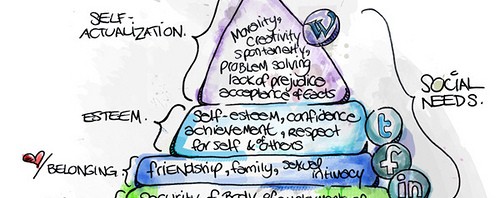The above image has been doing the rounds for a while, because it is an interesting premise to consider: Does social media fulfill a human need? If so, what better way is there to ponder this question than with Maslow’s Hierarchy of Needs?
When we look at why the most popular social media apps were invented, it was because they were answering specific needs. Needs which had arisen and were fulfilled because the Internet compresses time and space to create an environment of sharing:
- Flickr was invented to share photographs online.
- Instagram was invented to create polaroid style pictures for sharing.
- Facebook’s originated because people wanted an online Harvard student network and some say because Mark Zuckenburg wanted to invade peoples’ privacy.
- LinkedIn got started as an online business networking tool.
- Twitter came about as a way of sharing SMSs to lots of people simultaneously.
- YouTube was invented, so the story goes, so that a group of people could share videos of a wedding they had all attended.
- Pinterest was created so people could save and bookmark all the lovely pictures they found surfing the Internet.
- WordPress was invented so that people could easily blog online and have lovely pages without having to learn html/css.
Each one of these solved a need, which is why google+ did not become the next big thing in social media. Former Google employee Chris Messina says that whilst it was a good idea to stop Facebook’s major marketshare, google+’s only goal was to replace Facebook, and without a specific need to address, google+ tried too hard (and failed) to be everything to everyone.
What everything is to everyone is impossible to define, as we are constantly changing and adapting, which is why social media does not fit into Maslow’s Hierarchy in the way the image portrays.
Maslow said that humans begin at the bottom of the pyramid and then work their way up. So, once the need for food and water is satisfied, shelter is next, and so on. But, this is not how social media works. So, once I have created my identity on facebook, I don’t move up to the level of twitter for self-esteem. We use multiple social media channels simultaneously, so today when I finish this blog I will publicise its existence on facebook, twitter, google+, etc.
Instead, I believe that we have a fundamental human need to be seen and heard, valued and accepted, and our greatest need when it comes to social media is to share our human experiences good and bad, happy and sad, in order to make sense of them, and to feel connected. This is demonstrated by why the channels were invented in the first place. So, it is not the social media channel, the how we share, which should be fitted into Maslow’s hierarchy, it is what we share that fits into this pyramid.
Last summer, I went to the London Content marketing show which was packed full of great talks, which the audience tweeted throughout the day #contentmarketingshow. I listened to many talks about what types of information people share and what is the most popular type of information. As I took notes, I realised that you can categorise the information which gets shared most into the various levels of Maslow’s hierarchy of needs:
- Physiological: Information that make users fearful or angry is shared more often than information which makes them happy, because we all need to feel physically safe and we have that neanderthal fight or flight thing still going on.
- Safety: Information that helps others and is useful is shared informally or in a formal context such as online educating and learning for the workplace or the classroom, because we all like to feel safe and education is one way of ensuring our safety.
- Social: People share information about their identity – likes and dislikes, in groups or individually, because we all want to be seen and heard, and to belong and feel loved.
- Esteem: People share information as social currency: they look cool, they have the latest yoga pants or they have a skill, they blog about something they are knowledgeable, and can influence others, or they wish to be perceived as an influencer, because we need in society to respect ourselves and we like to respect and follow others.
- Self-actualization:People like to share compelling narratives – anecdotes, stories, pictures, quotation which have helped them grow or to they share to encourage others grow.
And, there is another category of information, which is one of surprise. The type of information which is shared more than anything else on social media is surprising information – in the form of stories, short videos, images, apparently, we all seek that twist in the tale.
Maslow added a similar category after he had completed his pyramid. He called it the self-transcendance or spirituality category. He put it at the top of the pyramid but stressed that it could go hand in hand with the lowest of needs such as food and water. Surprise does help us to transcend/forget ourselves or to see things in a different way.
Life coach Tony Robbins in his research refers to this as variety and say that although humans need certainty (Maslow’s physiological and safety needs), they also like variety and surprise. We crave new stimulus, to take us out of ourselves, to be lifted up and make our day.
And for me, this is the best bit of social media. Social media can make our day and lift us up. I believe that the person who drew this image thought that too, and gave social media the authority of Maslow’s hierarchy. Used correctly, social media can be a fast way for us to transcend ourselves and feel part of something bigger as we climb up our pyramid of needs.




